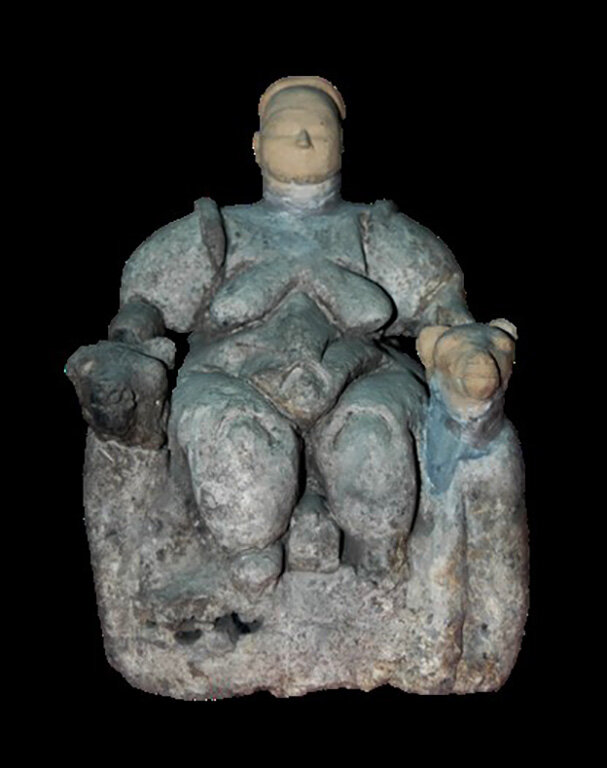who is the Neolithic Mother Goddess?
My current studies have taken me down the path of the Mother Goddess construct that was made popular in the 1980s and 1990s (and still is!) by American anthropologist and archaeologist, Marija Gimbutas. Gimbutus’ theory was driven by the idea that Palaeolithic and Neolithic society were dominated by a matriarchal structure, where the mother goddess figure played the central religious and ritualistic role. Her theory rests of the lack of evidence of male deity figurines in prehistory. As some female figurines have been dated to prehistory, she concluded that society was based on maternal and nurturing technologies that were nourishing, rather than destructive. Palaeolithic and Neolithic figurines that have been found at locations like Çatalhöyük and Willendorf are material examples of this matriarchal society that worshiped a Mother Goddess deity, represented by her voluptuous body indicating fertility and sexuality. She also argues that women’s bodies, and the planet, have been exploited by men throughout time and that this peaceful and nurturing period that she calls “Old Europe” was brought to an end by the Kurgan invasion. This group of men brought with them agriculture, violence and male deities. Thus ended the period of the female figurines she called Mother Goddess. (Meskell, 1998, pg 126-128)
Ronald Hutton, English historian and expert on British folklore and paganism, wrote a fascinating article titled, The Neolithic great goddess: a study in modern tradition (1997), where he explores the development of the goddess statues and figurines. He details how interpretations of the goddess are bound to the socio-political commentary at the time. In the 18thC, antiquities scholars reassessed the traditional meaning of the classical goddess statues of Venus, Minerva and Juno from patronesses to objects of love, chastity, maidenly virtue and wisdom. His timeline of changing interpretations reveals the plastic nature of statures and figurines - something that we have seen recently with the Black Lives Matter protests and how society’s acceptance of particular statues come into sharp focus. By the time of the early 1900s, Neolithic and Palaeolithic female figurines were routinely referred to as Mother Goddess or Earth Mother figures, which gave birth (pardon the pun!) to the New Age goddess religious movements , many of which continue today.
But what do contemporary archaeologists and anthropologists make of this Mother Goddess label? Since the 1990s, there has been extensive work done in Çatalhöyük under the directorship of Ian Hodder. Archaeologists, bioarchaeologists, ethnographers, anthropologists and scientists have converged on the site, drawing upon each other’s work to try to come to some understanding of the iconic feminine statues that were discovered by James Mellaart in 1961 - the very person who labelled them as mother goddess figures. So what have they concluded?
Overwhelmingly, there is no evidence to suggest that the small number of anthropomorphic female figurines constitute a matriarchal or female driven religion at Çatalhöyük. Rather, new interpretations lean towards understanding the figurines in terms of abundance and wealth or wisdom, not fertility and sexuality (Meskell et al, 2008).
So where does that leave the Mother Goddess groups? This is where science meets belief and the arguments for both sides are equally fascinating, although only one side refers to science.
I’ve included a very short list of references here if you are interested to explore even further, and I suggest that you do, as it is an engaging rabbit hole.
Go forth and conquer!
References:
Gimbutas, M. (1991), The Language of the Goddess: Unearthing the hidden symbols of Western civilization, Harper Collins: New York.
Hamilton, N. (2005), “The figurines”, in I. Hodder (ed.) Changing Materialities at Catalhöyük: reports from the 1995-1999 seasons, Cambridge: London, pp 187-213.
Hodder, I (2011) Çatalhöyük The Leopard’s Tale: Revealing the mysteries of Turkey’s ancient ‘town’, Thames and Hudson: London.
Hutton, R. (1997), ‘The Neolithic goddess: a study in modern tradition”, Antiquity 71, pp 91-9.
Meskell, L. (1998) “Oh my goddess! Archaeology, sexuality and ecofeminism”, Archaeological Dialogues 5, pp.126-42.
Meskell, L., Nakamura, C., King, R., and Farid, S. (2008) “Figured Lifeworlds and dispositional practices and Çatalhöyük”, Cambridge Archaeological Journal 18:2, pp. 139-161.


